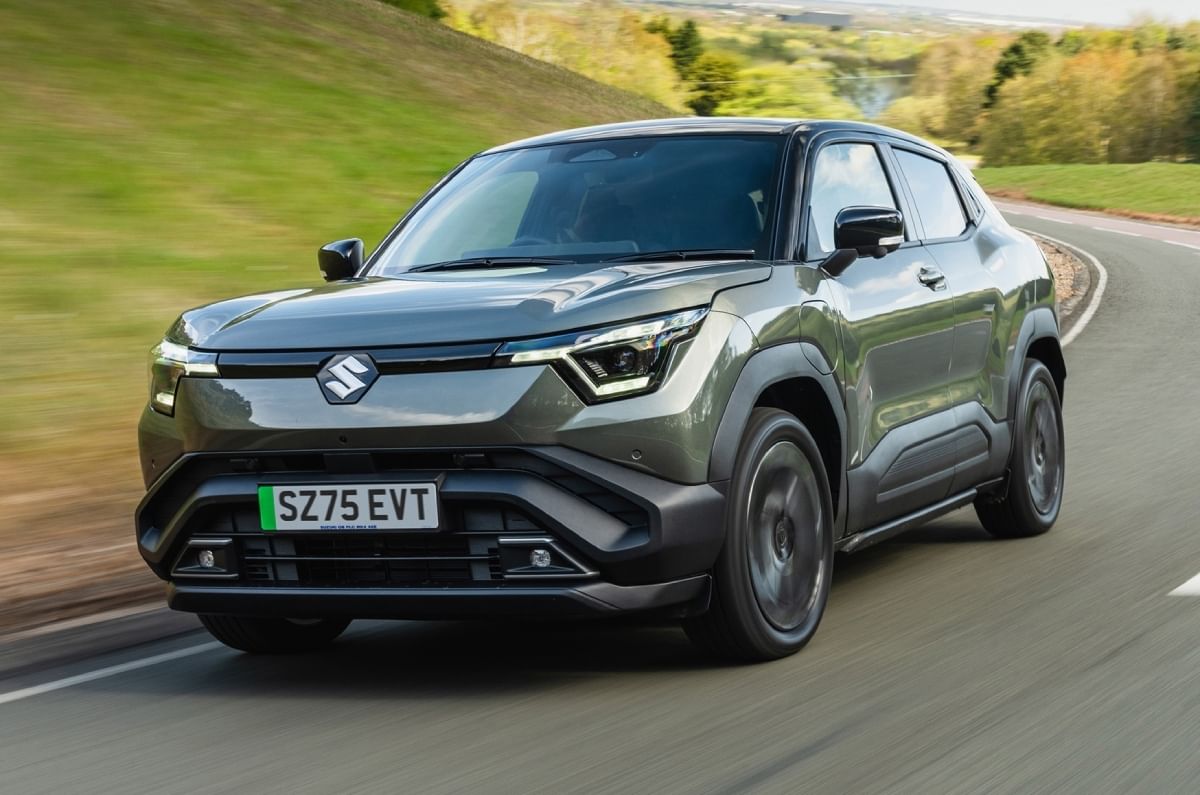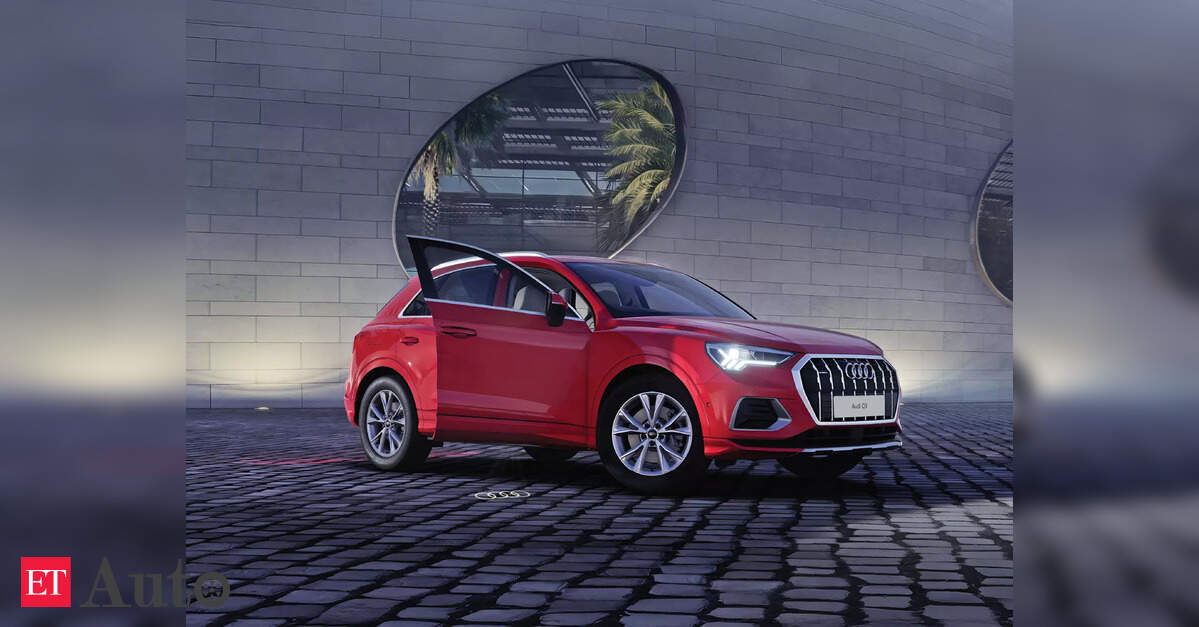With EVs picking up pace in India, Maruti Suzuki needs an electric car to protect its market share, and for Europe, it needs an EV to balance its average fleet emissions. Despite having fuel efficient small cars, an absence of an EV meant Suzuki failed to meet tightening European norms and had to discontinued sales of the Jimny. So, Suzuki’s first EV, the e Vitara, is a strategically important one.
Suzuki e Vitara exterior design and engineering – 7/10
Bears a Suzuki resemblance but looks handsome and unique with a sharp and muscular style.
The e Vitara will be exclusively made in India for all global markets and the company says it’s been built on an all-new EV platform that it calls Heartect-e. There are traits though that indicate ICE platform roots. For one in 2-wheel drive format – it has AWD too – the primary motor is at the front, typically born electrics prefer locating the main / sole motor at the rear to lower the massive torque load on the front steering wheels. Rear mounting also means less mass to manage in a crash and space for a frunk, which the e Vitara lacks. Either way there’s massive engineering at play and what’s nice is that it does not share its top hat with any other Suzuki model.

At the front the styling is nicely muscular with prominent angles and protrusions and the large side cladding adds to this look. Tyre rims are aero styled ones and large at 19 inches. Like the front the rear too has been carved out with sharp cuts of the chisel and while the rear lights are connected by a transparent bar, the central portion isn’t illuminated which is refreshingly different from the all-too-common connected light bar style. Atop there’s a spoiler and flanked by prominent buttresses.
| Dimensions | |
|---|---|
| Length (mm) | 4,275 |
| Width (mm) | 1,800 |
| Height (mm) | 1,635 |
| Wheelbase (mm) | 2,700 |
| Ground clearance (mm) | 180 |
| Wheel size (inch) | 19 |
| Boot space (litres) | 238-306 |
Suzuki e Vitara interior space and comfort – 6 /10
Good legroom but rear headroom and boot space are tight.

Space at the front is good and the seats are comfy and supportive though larger frames may find it narrow. Headroom is good at the front however at the rear its very tight. You can recline the backrest but my 5-foot 8-inch frame had just about a three-finger gap to the scooped-out headliner, taller folks will definitely find their heads touching. Leg room isn’t an issue though, uniquely the rear seats slide fore and aft to adjust space between rear passenger legroom and cargo volume. Boot space is tight tough, with the seats slid all the way back, space is only 238 litres, it increases to 306 litres – still small – with the seats at the foremost position. Maruti says the India car will have a larger boot but this will be on account of a reprofiled under floor storage tray and perhaps a different measuring method, so don’t hold your breath for class leading cargo volume. The rear seat backs also fold down in a 40:20:40 split. Other interior storage comprises of cupholders, a center console box, and also an open space under the floating center console.
Suzuki e Vitara features and safety – 8 / 10
Well-built and well specced with all the expected features in its class.

The insides are well built and there’s a nice quality feel about the cabin. It’s fairly radical too, certainly so by Suzuki’s typically safe approach. The dashboard is asymmetrical with the center AC vents and controls off-set to the left and away from the driver giving it a bit of a funky vibe. Another funky element is the offset instrument panel and center touchscreen, but it comes off looking very odd and will be an OCD freaks nightmare. The 10-inch screens are held within the same single glass pane but the IP screen is set much lower than the touchscreen leaving a very fat bezel at the top, oddly enough it’s not to house the driver monitoring system, that’s housed in a small binnacle on top of the steering column.

The car we drove was well equipped with keyless entry, 360-degree camera, a sunroof, wireless phone charger, powered drivers’ seat, Infinity branded audio with a subwoofer and wireless Android Auto and Apple Car Play. On the safety front our car came equipped with 7 airbags and a full ADAS suite.
Suzuki e Vitara performance and refinement – 7 /10
Not lively and peppy but quick and predictable performance.
The e Vitara comes with a 49kWh battery powering a 144hp motor or a more powerful 174hp output from a 61kWh battery, with both versions put out 189Nm of torque. There’s also a dual motor all-wheel-drive version with 184hp and 300Nm of torque. We drove the 174hp version as the all-wheel-drive model isn’t likely to be launched here. On the face of it, 174hp is a lot and held against a clock its quick too with a claimed 0-100 kph time of 8.7 seconds. However, it does not feel that quick with a very linear power delivery and a gentle roll off the line even in Sport mode.

Those looking for that lively performance typical of many EVs will be left wanting, the setup leans towards an easy to drive character with enough performance for the highway and to pull off safe overtakes, perfect for a family EV.
At high double-digit speeds there is a lot of wind and tyre noise and rather than it being a matter of design it comes off more as a case of less insulation. It does get disconcerting especially so with steady high-speed cruising.
Braking is via discs all around and there’s adjustable levels of regen, but there aren’t steering paddles to cycle between them, rather you have to first set the level you want via the touchscreen and then to access that preset level you need to press a button on the center console; not user friendly, it would have been so much better if the button at least cycled through the various levels.
| Battery, power and range | |
|---|---|
| Battery capacity (kWh) | 61 |
| Drive layout | FWD |
| Motor power (hp) | 174 |
| Maximum torque (Nm) | 189 |
| Range (km) | 428 (WLTP) |
| 0-100kph (seconds) | 8.7 (claimed) |
Suzuki e Vitara range and efficiency – 7 / 10
Expect par for course real world range.
The e Vitara uses LFP blade cells which are not very energy dense but are easier to handle when it comes to thermal management and in the UK, the 41kWh battery version has a claimed range of 344 kms while the 61kWh battery delivers 428 kms. Not class leading and while Maruti says the India car will give 500 + kms, this will most likely be on account of a different cycle and not a change in battery size.
Charging the 61kWh battery takes 5 hours and 30 minutes to go from 10 to 100% on a 11kW AC charger while plugged into a 70kW DC fast charger going from 10 to 80% will take 45 minutes.
Suzuki e Vitara ride comfort and handling – 8 / 10
A firm and typically European composure.

The ride and handling balance is typically European, not something you’d say of a Maruti. Given this car’s European focus its suspension set up is firm and its composure is good around corners. The ride isn’t plush and pliant at low speeds and so it remains to be seen how well the e Vitara will tackle potholes and bad roads. Steering weight too its typically European so it isn’t one finger twirl light but comfy enough for parking manoeuvres and it weights up with speed and in Sport mode.
Suzuki e Vitara price and value for money – 7 /10
Not electrifying, but is an easy to drive and well-built EV.
The e Vitara is not your typical Maruti that checks all boxes. Space isn’t a strong point with limited rear headroom and a small boot, and efficiency too is far from class leading. There are other negatives too like a lack of punch from the drivetrain that won’t find favour with the thrill seekers.

But, not being a typical Maruti also means the interiors don’t feel built to a cost and it should arrive well equipped too, something which Maruti has finally been paying heed to. The e Vitara’s easy to drive character will also appeal to those looking for a relaxed every day car, and what’s nice is that it’s a handsome looker and doesn’t share its top hat with any other Suzuki model. So, its distinctive and buying one easily signals you’ve gone electric, something its main rival, the electric Creta does not do and seems to be suffering for.
On the whole then, the e Vitara has its work cut out for it. All that’s left then is pricing. At the low end expect the smaller 41 kWh battery to go toe-to-toe or even undercut the 42kWh electric Creta, so a starting price around Rs 17 lakh is likely. At the higher end though the battery sizes differ with the Hyundai coming in at 51kWh and the Suzuki at 61Kwh, so it will be interesting to see if Maruti can pip the Hyundai at the top end too, which is at the Rs 24 lakh mark. These long-time rivals who have gone head-to-head in nearly every segment will now meet on the electric field too, Game on!
Select images courtesy Autocar UK
Also see:
Maruti e Vitara walkaround video at Auto Expo 2025
Maruti e Vitara vs Toyota Urban Cruiser EV: design, specs, features compared


